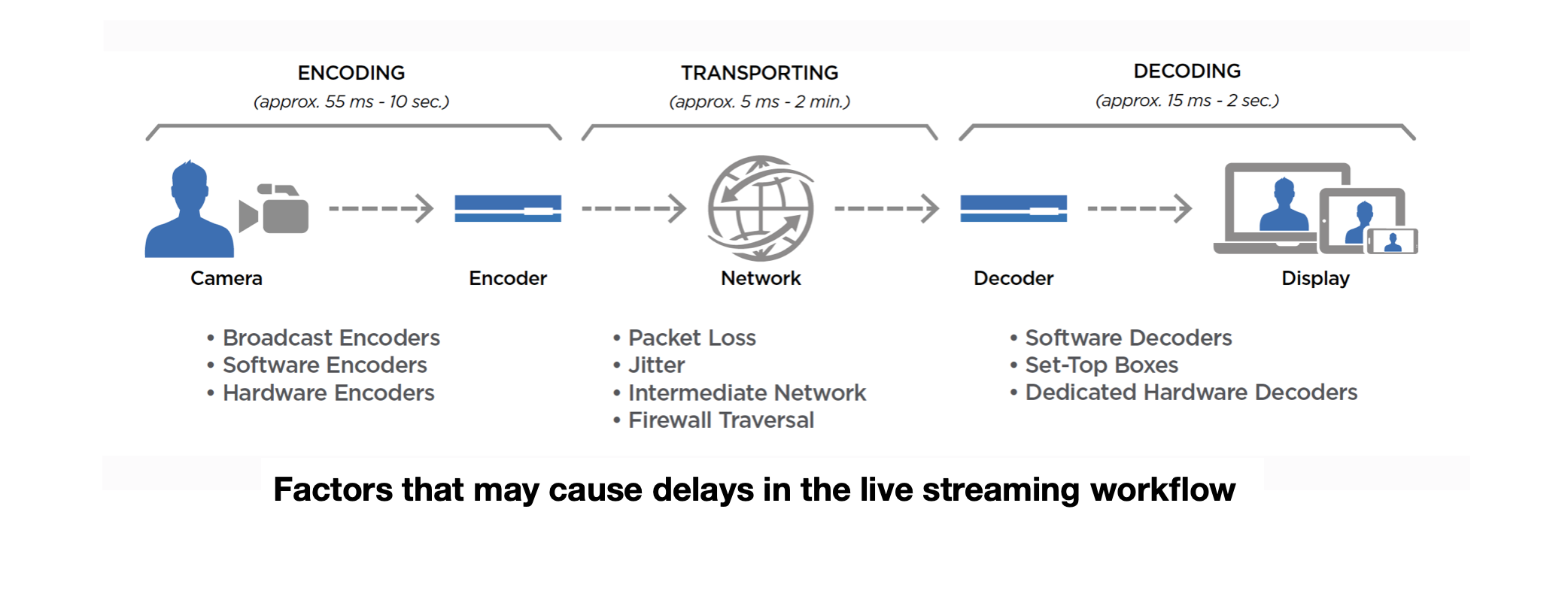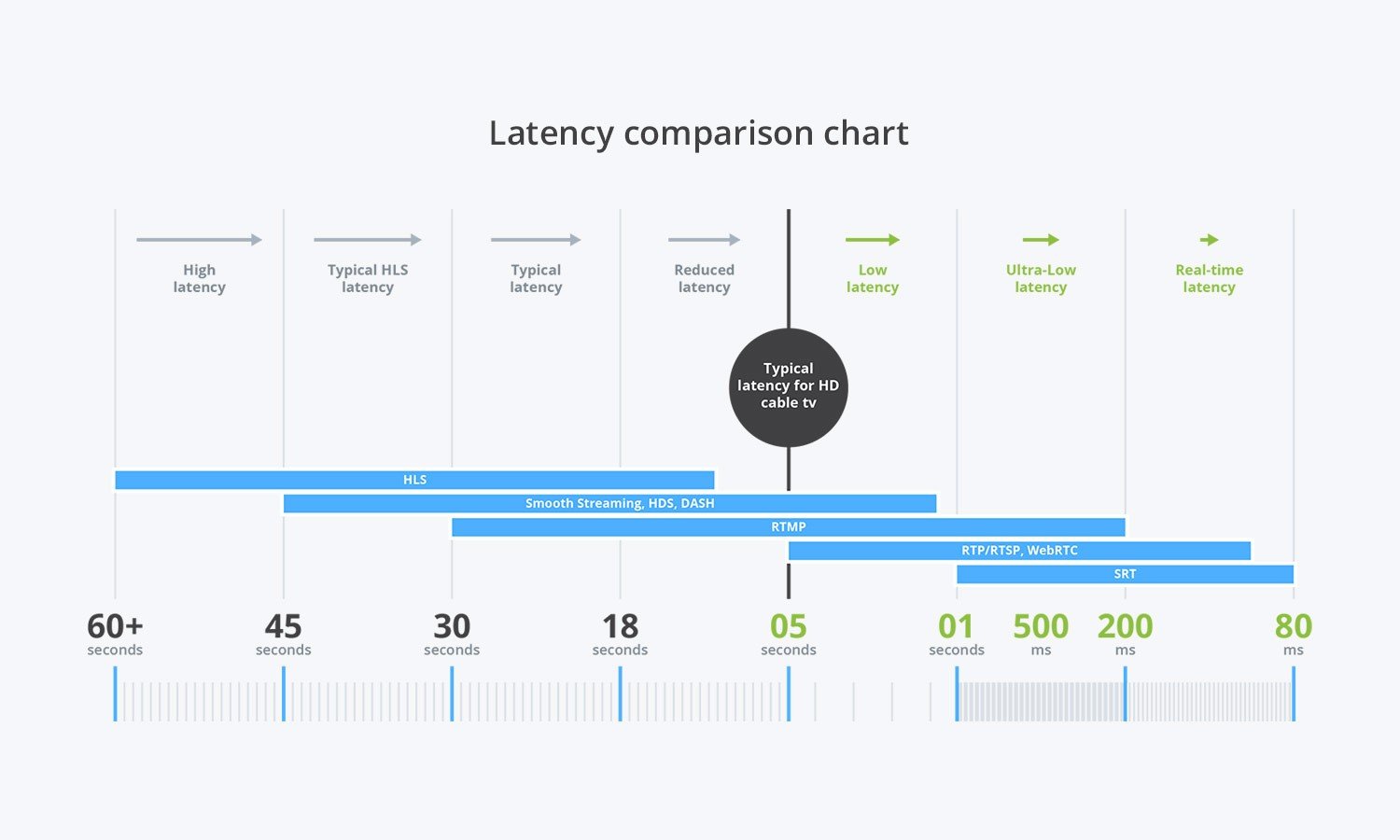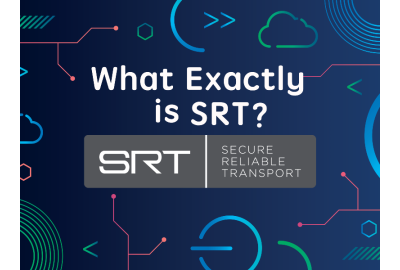What is the SRT protocol?
Haivision created Secure Reliable Transport (SRT) in 2012 as an open-source video transport protocol. It was created to provide secure, low-latency, and high-quality Internet video transmission. The protocol is optimal for live streaming and other applications that require minimal latency and maximum reliability.

How SRT Operates?
The SRT protocol delivers video broadcasts using a combination of UDP (User Datagram Protocol) and ARQ (Automatic Repeat Request). UDP enables rapid data transmission, while ARQ ensures the stream's integrity by requesting the retransmission of packets that were lost.
Additionally, SRT uses error correction techniques and adaptive bitrate streaming to optimize video quality and reduce latency. These characteristics allow the protocol to adapt to varying network conditions, making it suitable for transmission over unreliable networks such as the Internet.
SRT Features
Among the main characteristics of the SRT protocol are:
- SRT's end-to-end latency is as low as 120 ms, making it suitable for live streaming and remote production applications.
- SRT employs AES (Advanced Encryption Standard) encryption to prevent unauthorized access and interception of video transmissions.
- The protocol employs error correction techniques to recover lost packets and sustain video quality during error recovery.
- SRT automatically adjusts the video bitrate based on network conditions to optimize quality and minimize latency.
- As an open-source protocol, SRT fosters collaboration and innovation in the video streaming community.
Benefits of using SRT Protocol
Superior Video Quality
SRT ensures high-quality video streaming under challenging network conditions by employing adaptive bitrate streaming and error recovery techniques. The protocol can adapt to changes in bandwidth and packet loss, allowing it to maintain video quality without sacrificing latency.
Very Low Latencies
Live transmission and remote production applications require low latency. The low-latency performance of SRT enables real-time interactions and fluid video playback, thereby enhancing the viewing experience for users.
Security
The SRT protocol employs AES encryption to prevent unauthorized access and interception of video transmissions. This security feature is essential for preserving the confidentiality and integrity of video content, especially for sensitive or copywritten material.
The open-source
RT promotes collaboration and innovation within the video-streaming community. This transparency enables developers to access the protocol's source code and contribute to its development, resulting in ongoing performance and functionality enhancements.
Comparative of SRT and Other Video Streaming Protocols
SRT vs. RTMP
Real-Time Messaging Protocol (RTMP) is a protocol extensively used for streaming video and audio over the internet. However, it has several disadvantages compared to SRT, including:
RTMP has a higher end-to-end latency than SRT, making it less suitable for live broadcasting and remote production applications.
RTMP is less secure than SRT due to its lack of inherent encryption. Additional measures, such as Secure Sockets Layer (SSL) or Transport Layer Security (TLS), are required to defend RTMP streams.
Less resilient to network fluctuations: RTMP is less adaptable to changing network conditions, which can result in a decrease in video quality and an increase in streaming latency.
SRT vs. WebRTC
Web Real-Time Communication (WebRTC) is a popular protocol for browser-to-mobile application real-time communication. It is frequently used in video conferencing and other interactive applications. While WebRTC offers some advantages, such as native browser support and simple implementation, it differs from SRT in the following ways:
WebRTC is predominantly designed for real-time communication between small groups of users, whereas SRT is better suited for large-scale video streaming applications.
WebRTC may offer inferior video quality compared to SRT, particularly when streaming over unreliable networks.
WebRTC has less sophisticated error recovery mechanisms than SRT, making it more susceptible to packet loss and network fluctuations.
SRT vs. HLS
Apple's HTTP Live Streaming (HLS) is a widely used streaming protocol. It functions by slicing video content into tiny pieces and delivering them over HTTP, making it compatible with a variety of devices and networks. While HLS is a popular choice for video transmission, SRT is distinguished by the following:
HLS has substantially greater latency than SRT as a result of its chunk-based delivery method. This makes SRT a superior option for applications involving live transmission and remote production.
Similarly to RTMP, HLS does not include inherent encryption. To secure HLS transmissions, additional measures are required, such as the use of HTTPS.
Less adaptable to network fluctuations: Compared to SRT, HLS is less capable of adapting to changing network conditions, which can result in a decrease in video quality and an increase in latency.
List of Products / Devices / Software with support SRT Protocol.
- Kiloview NDI HX series, P series, S series, E series, G series, U series
- NewTek TriCaster TC2 Elite, TC1, 410 Plus, Mini 4K, TriCaster XD system with Advanced Edition 3 (Mini HDMI, Mini SDI, 410, 460, 860, 8000), NewTek VMC, Connect NC1 IO
- AIDA, AIDA Imaging HD-NDI-VF
- AJA Video Helo Plus
- BirdDog Cloud
- Datavideo Datavideo PTC-300 4K, Datavideo PTC-300NDIW 4K, Datavideo NVD-40, Datavideo NVD-35
- JVC, JVC KY-PZ200, JVC KY-PZ400N 4K, JVC KY-PZ200N HD, JVC KM-IP8 vMix Studio Switcher, JVC KY-PZ510 4K, JVC KY-PZ510 NDI.
- Magewell, Magewell Pro Convert, Magewell Pro Convert NDI to HDMI 4K
- Panasonic, Panasonic AW-UR100, Panasonic AJ-CX4000GJ Pro, Panasonic AW-HE145, Panasonic 4K NDI Pro.
- PTZOptics, PTZOptics Move 4K, PTZOptics Link 4K, PTZOptics Studio Pro, PTZOptics Move SE
- Teradek, Teradek Prism 853, Teradek Prism Mobile 857,
- SONY, Sony Compact UHD 4K.
- vMix
Conclusion
SRT protocol is a novel solution for secure, low-latency, and high-quality video transmission. Its open-source nature, sophisticated features, and network adaptability make it an attractive option for live streaming, remote production, and other applications that require minimal latency and maximum reliability.
SRT offers several advantages over other prominent video streaming protocols such as RTMP, WebRTC, and HLS in terms of latency, video quality, and security. By understanding the fundamentals of the SRT protocol and its benefits, content creators and video streaming service providers can choose the optimal protocol for their specific requirements.





